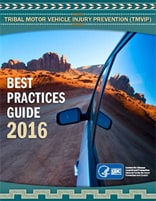Tribal Road Safety

Motor vehicle traffic crashes are a leading cause of death for American Indian and Alaska Native people.1 CDC’s Injury Center works with tribal communities to implement motor vehicle injury prevention programs, reduce injuries, and save lives.
Learn more about American Indian and Alaska Native peoples’ risks on the road and how crash-related injuries and deaths among members of tribal nations can be prevented.
American Indian and Alaska Native people are injured or killed in motor vehicle crashes at much higher rates than other racial and ethnic groups.*
- Motor vehicle traffic death rates among American Indian and Alaska Native children and youth ages 0–19 years are up to 8 times higher than those of other racial and ethnic groups.1
- Rates of motor vehicle traffic deaths among American Indian and Alaska Native adults ages 20 years or older are more than twice that of White people.1
- Seat belt use among American Indian and Alaska Native people (79%)2 is lower than that of the United States overall (90%).3
- Almost 2 out of every 3 passengers who died in crashes on reservations were not wearing seat belts at the time of the crash.4
- American Indian and Alaska Native people have the highest alcohol-impaired driving death rates among all racial and ethnic groups. Alcohol-impaired driving death rates among American Indian and Alaska Native people are 2 to 11 times higher than other racial and ethnic groups.5
*On this webpage, statistics are reported for non-overlapping racial and ethnic groups. All people of Hispanic origin are grouped together, so statistics for American Indian and Alaska Native people and White people are for those who do not identify as Hispanic.
- Tribal Road Safety: Get the facts
- CDC Transportation Safety
- CDC Menu of Selected Tribal Laws Related to Motor Vehicle Safety [PDF – 7 pages]
- Native American Heritage Month
- Indian Health Service – Injury Prevention
- The Community Guide
- Bureau of Indian Affairs (BIA) Indian Highway Safety Program
- CDC Tribal Health
The Tribal Toolkit is available to assist tribes in the promotion of recommended strategies that consider the unique culture of American Indians and Alaska Natives. The toolkit includes fact sheets and posters to increase seat belt use, increase child safety seat use, and to reduce alcohol-impaired driving.
- Centers for Disease Control and Prevention (CDC). WISQARS — Web-based Injury Statistics Query and Reporting System. Atlanta, GA: U.S. Department of Health and Human Services, Centers for Disease Control and Prevention, National Center for Injury Prevention and Control; 2022
- Bureau of Indian Affairs (BIA), Indian Highway Safety Program (IHSP). FY 2021 Annual Report. Albuquerque, NM: U.S. Department of the Interior, Bureau of Indian Affairs, Bureau of Indian Affairs, Office of Justice Services.
- National Highway Traffic Safety Administration (NHTSA). Traffic Safety Facts: Seat Belt Use in 2021—Overall Results (Report No DOT HS 813 241). Washington, DC: U.S. Department of Transportation, National Highway Traffic Safety Administration, National Center for Statistics and Analysis. December 2021.
- National Highway Traffic Safety Administration (NHTSA). Native American Traffic Safety Facts FARS 2015–2019. Washington, DC: U.S. Department of Transportation, National Highway Traffic Safety Administration, National Center for Statistics and Analysis.
- National Highway Traffic Safety Administration (NHTSA). Unpublished 2015–2019 data from the Fatality Analysis Reporting System (FARS). Washington, DC: U.S. Department of Transportation, National Highway Traffic Safety Administration, National Center for Statistics and Analysis; August 2022.
Over the last several years, many American Indian and Alaska Native tribes and tribal organizations put motor vehicle injury prevention strategies into action. CDC collaborated with the Indian Health Service (IHS), the Bureau of Indian Affairs (BIA), and the University of North Carolina (UNC) to develop a best practices guide to share lessons learned from this work.
